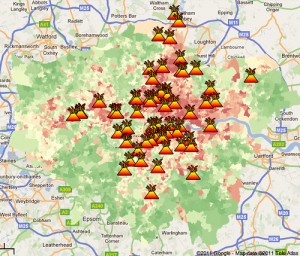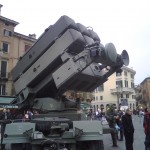 Why were the London/UK riots allowed to happen? Why was it not stopped sooner? What was the root cause of it? How can we stop it happening again? When/how are we going to punish the people who did this?
Why were the London/UK riots allowed to happen? Why was it not stopped sooner? What was the root cause of it? How can we stop it happening again? When/how are we going to punish the people who did this?
It will be very difficult to come to any answers that do not fall back upon previously held ideological viewpoints. Whatever political conception you had beforehand is likely the one that will be strengthened by these recent events and the one you will formulate understanding around.
For those who are not as politically invested, the emotion of the situation will lead to desperate and justified pleas for social order and normality to be restored by any means possible.
The questions surrounding these recent acts of wanton and despicable violence are unfortunately too complicated to answer with one universal message (although one that recognises the ‘epidemic of nihilism’ is the best I’ve seen yet) – but even if we could, an understanding of why will probably not provide us with immediate avenues for change. By this point, the problem is clearly so ingrained that it will take a very long time to overcome and there will not be one answer but many. In some instances it is education, in others social inclusion, others spirituality, or economic mobility, community spirit, personal development etc. etc.
One thing that is quite clear, however, is that this current crisis in the framework of society revolves around a single word: violence. The actions that cause us such distress do so because they are acts of violence; looting, burglary, arson, assault are all scary examples of what we are capable of committing against one another when people lose respect for humanity and the social contract which binds us together. When this social contract breaks down, it is a terrifying experience that rightly causes a lot of fear.
Visible violence brings about in us a very primal response, a deeply emotional need to overcome at any cost. This is particularly so when it is as chaotic as it has been over recent days. Our reaction can be very admirable; the communities of Turks and Sikhs that came out to calmly defend their streets; the neighbours who checked in on one another (meeting for the first time); or the ‘broom army’ that highlighted the solidarity against senseless destruction that the vast majority of society stand firmly against. Visible violence often brings us together, and this is as true for those committing the violence as it is for those rallying against it. It was the visibility of violence that led to the mass display of nihilistic hysteria that we have seen over the last few days.
Visible violence creates such an intense emotional response through being tangible; confrontational; present. This is particularly so when it violates the sanctity of people – their homes, livelihoods, bodies – because that causes us to empathise with and internalise the suffering. But what we are missing is that visible violence is only one aspect of what it means to act violently, and the majority of violent acts are actually not visible at all.
Whereas visible violence often results in us coming together, there are also many forms of invisible violence which serve to tear us apart. These are the forms that people who are trying to make sense of this wanton destruction are referring to in their search for answers. Both sides of the political spectrum rely upon them: wealth disparity, social exclusion, lack of family values, failure of education, loss of moral compass etc.
All of these examples are the result of invisible forms of violence that are difficult for us to become overtly passionate about because they do not directly interface with our primal response. Part of the problem with current rhetoric surrounding the London and UK riots is that we are minimising the fact that these issues have themselves emerged from acts of structural violence embedded within society; they just aren’t entirely obvious, physical acts of violence.
For example, an analysis of the riots that refers to socioeconomic problems and social exclusion will see current events as indicative of flaws in the social order – but they will not openly refer to them as acts of violence upon the people who feel their effect. In some ways it feels inappropriate to do so when faced with the very present and immediately damaging violence that we were all shocked by in these riots. This is because to refer to them as acts of violence within current rhetoric we require a perpetrator, an author of violence which is often only possible to recognise when it comes to visible forms.
We have this problem because we are limiting our understanding of and response to violence. The irreverent and criminal chaos of the London riots manifested as visible violence because for many this is the only language of response that they understand to the unconscious nihilism that informs them. It has reached a point where many have no concept of what it is they are responding to, just that they want to respond to something within their psyche that tells them to lash out. That feeling has been created by the many acts of invisible violence that have been inflicted upon these people and that they then perpetuate upon themselves, their families and their peers. The vast majority will not respond with acts of visible violence, and even less with senseless ones such as what we have seen here, but that is often because the levels of invisible violence that they are subjected to are nowhere near as all-encompassing; there is usually a clearer path out and this breeds a sense of hope and decency.
 To say this says nothing of legitimising a violent reaction – and it does not at all try to justify one – but is instead to demand that we rally against the concept of violence in all of its forms. The visible violence of the UK riots should be condemned with appropriate punitive measures, and it should be done so swiftly and conclusively because society cannot accept such a rejection of our ideals of community, peace and solidarity.
To say this says nothing of legitimising a violent reaction – and it does not at all try to justify one – but is instead to demand that we rally against the concept of violence in all of its forms. The visible violence of the UK riots should be condemned with appropriate punitive measures, and it should be done so swiftly and conclusively because society cannot accept such a rejection of our ideals of community, peace and solidarity.
The tragedy of people losing their homes, of being beaten, robbed and even killed is to be responded to with a forceful rallying of the power of communal response to those who wish to undermine our well-being. But we must equally rally against and condemn the other forms of violence that are less easy to pinpoint in time and place.
Where is our passionate and unified call for an end to the invisible forms of violence that also undermine our well-being, and in many ways created the foundation for this behaviour?
If we examine the context of violence of the rioters themselves, as real people not just as one-dimensional perpetrators, then we can begin to see some of the forms that we overlook. The visible manifestation we are seeing is an unconscious reaction to the ideological, economic, educational, structural, social and linguistic violence that these people are being subjected to or subject themselves to.
What is most important at the moment is the recognition that something must change because this isn’t working, and I would argue that the change must be a condemnation of violence in all of its forms before we get too caught up in our condemnation of visible violence alone. Visible violence is often the most impacting on our safety and the kind that can directly threaten our life, but this does not mean that we cannot also see the true impact that invisible violence has. For many people who live in extreme poverty around the world, those that are starving to death every single day, they are subjected as communities to invisible forms of long-running socioeconomic violence that do directly threaten their lives. Yet we feel less emotional distress or desire to rectify the source of that violence because it is less present and our primal fear of it is so distant.
Think of the linguistic and symbolic violence that has led to vast swathes of our society being branded ‘losers’, ‘scum’, ‘uneducated morons’, ‘benefit slobs’, ‘hoodies’, ‘youths’. Such linguistic violence is also committed against the opposite end of the socioeconomic spectrum when we use words such as ‘toffs’, ‘posh’, ‘spoonfed’. It is classically used against women (slags, sluts, chicks, hoes), ethnicities of all colours and nationality and those of different sexuality or religion. All forms of linguistic violence serve to oppress the breadth of identity that the people we utilise them against embody. When we consistently use language as a form of invisible, symbolic violence we create stereotypes that do nothing but segregate society, tearing us apart by promoting a lack of empathy or compassion and often becoming self-fulfilling prophecies.
Consider also the overt political and economic violence that has been inflicted upon the local and global economies through the actions of greedy or short-sighted individuals (most of them are not bankers, by the way) that have quite literally looted trillions of dollars. Trillions of dollars that were looted invisibly and therefore the emotional response has not been as forcefully or consciously articulated. How can an MP such as Hazel Blears or Gerald Kaufman stand up in parliament denouncing the moral depravity of these looters and yet they themselves stole thousands of pounds from the taxpayers in the expenses scandal – why do we allow them to do this? This is not quite the same as the structural violence mentioned earlier (although it is assisted by it), but it can still be considered an invisible form of violence (maybe semi-visible) because it is not immediately present or physically confrontational and therefore our response to it is not as emotionally charged.
The vast majority of people I know and heard through social media were calling during the London riots for Martial Law to be imposed, and a large swathe of them were openly calling for the looters and perpetrators of visible violence to be shot or other such escalations. Yet relatively few felt a need to respond to the political hijacking of the US economy in the recent debt crisis negotiations, a deeply violent act that will have unpredictable repercussions for billions of people around the world.
The London riots and their counterparts around the UK are causing us to move further towards an understanding of violence that is limited only to physical, visible acts. This is deeply problematic because visible acts of violence are often a direct response to the collective weight of a multitude of invisible acts of violence embedded into the very structure of society. This does nothing to justify or legitimise the visible acts of violence, and they must be decisively dealt with, it just demands that we mature our understanding of violence and do not limit it only to those things which engender a primal response within our psyche.
We must move beyond politics Left/Right and recognise that we collectively desire to overcome violence in all of its forms. Violence is both visible and invisible, but the response to the UK riots at the moment is one that only ever refers to visible manifestations with the term ‘violence’. To do this helps to legitimise the forms of violence that are invisible, which is one of the most violent acts that we can collectively be responsible for.




